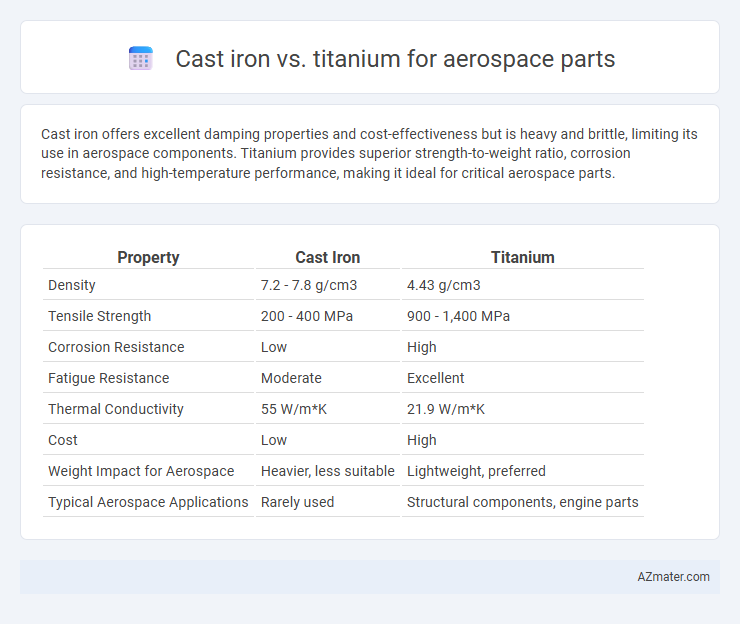Cast iron offers excellent damping properties and cost-effectiveness but is heavy and brittle, limiting its use in aerospace components. Titanium provides superior strength-to-weight ratio, corrosion resistance, and high-temperature performance, making it ideal for critical aerospace parts.
Table of Comparison
| Property | Cast Iron | Titanium |
|---|---|---|
| Density | 7.2 - 7.8 g/cm3 | 4.43 g/cm3 |
| Tensile Strength | 200 - 400 MPa | 900 - 1,400 MPa |
| Corrosion Resistance | Low | High |
| Fatigue Resistance | Moderate | Excellent |
| Thermal Conductivity | 55 W/m*K | 21.9 W/m*K |
| Cost | Low | High |
| Weight Impact for Aerospace | Heavier, less suitable | Lightweight, preferred |
| Typical Aerospace Applications | Rarely used | Structural components, engine parts |
Introduction to Aerospace Materials
Cast iron and titanium represent two contrasting materials used in aerospace applications, each offering distinct mechanical properties and weight considerations essential for aircraft design. Titanium's high strength-to-weight ratio and excellent corrosion resistance make it a preferred choice for critical aerospace components, whereas cast iron's high density and brittleness limit its applicability in high-performance environments. Advances in aerospace materials prioritize lightweight, durable, and fatigue-resistant metals, positioning titanium as a superior option for structural and engine parts over cast iron.
Key Properties of Cast Iron
Cast iron exhibits excellent compressive strength and wear resistance, making it valuable for certain aerospace components requiring durability under heavy loads. Its high carbon content provides good vibration damping, crucial for reducing mechanical noise and fatigue in aerospace structures. However, cast iron's brittleness and lower tensile strength compared to titanium limit its use in parts subjected to extreme stress or weight-sensitive applications.
Key Properties of Titanium
Titanium exhibits exceptional strength-to-weight ratio, corrosion resistance, and high-temperature tolerance, making it ideal for aerospace parts compared to cast iron. Its low density (4.5 g/cm3) significantly reduces aircraft weight while maintaining structural integrity under extreme conditions. The alloy's superior fatigue resistance and biocompatibility further enhance performance and longevity in aerospace applications.
Strength-to-Weight Ratio Comparison
Titanium exhibits a superior strength-to-weight ratio compared to cast iron, making it ideal for aerospace parts where minimizing weight is crucial without compromising structural integrity. Cast iron, while strong and durable, is significantly denser, leading to higher component weight and reduced fuel efficiency in aerospace applications. Titanium alloys combine high tensile strength with low density, enhancing performance and contributing to overall aircraft weight reduction.
Corrosion Resistance in Aerospace Environments
Titanium exhibits superior corrosion resistance compared to cast iron in aerospace environments due to its stable oxide layer that prevents oxidation and degradation. Cast iron is prone to rust and pitting when exposed to moisture and salt, making it less suitable for long-term aerospace applications. The enhanced corrosion resistance of titanium contributes to increased durability, reduced maintenance, and improved overall performance of aerospace components.
Fabrication and Machining Differences
Cast iron offers excellent machinability due to its graphite content, allowing easier cutting and shaping with lower tool wear, making it suitable for complex aerospace components requiring precise fabrication. Titanium, while offering superior strength-to-weight ratio and corrosion resistance, poses significant machining challenges, including work hardening and increased tool wear, necessitating specialized cutting tools and slower feed rates. The choice between these materials hinges on balancing fabrication ease and machining efficiency against performance requirements in aerospace applications.
Cost Analysis of Cast Iron vs Titanium
Cast iron offers significantly lower material and manufacturing costs compared to titanium, making it an economical choice for aerospace components with less critical weight constraints. Titanium's higher price stems from its complex extraction, processing, and machining requirements, but it delivers superior strength-to-weight ratio and corrosion resistance. Evaluating total lifecycle costs, including maintenance and fuel efficiency impacts, is essential to determining the optimal material between cost-effective cast iron and high-performance titanium in aerospace applications.
Performance Under Thermal Stress
Titanium outperforms cast iron in aerospace applications under thermal stress due to its superior high-temperature strength and excellent corrosion resistance. Cast iron tends to suffer from thermal fatigue and degrades faster, limiting its reliability in extreme conditions. The low density and high strength-to-weight ratio of titanium make it ideal for components subjected to rapid temperature fluctuations and intense thermal loads.
Common Aerospace Applications
Cast iron is rarely used in aerospace due to its high density and brittleness, making it unsuitable for critical structural components. Titanium alloys dominate aerospace applications with their exceptional strength-to-weight ratio, corrosion resistance, and ability to withstand extreme temperatures, commonly used in airframe structures, engine components, and landing gear. The aerospace industry prioritizes titanium for parts requiring durability and weight reduction, while cast iron is mostly limited to non-structural uses such as tooling or manufacturing equipment.
Future Trends in Aerospace Material Selection
Titanium alloys are increasingly favored in aerospace part manufacturing due to their superior strength-to-weight ratio, corrosion resistance, and ability to withstand extreme temperatures, driving a shift away from traditional cast iron components. Advanced additive manufacturing techniques enable the production of complex titanium parts with reduced waste and enhanced performance, aligning with sustainable aviation goals. Emerging trends emphasize lightweight, high-performance materials like titanium to improve fuel efficiency and reduce carbon emissions in next-generation aerospace designs.

Infographic: Cast iron vs Titanium for Aerospace part
 azmater.com
azmater.com